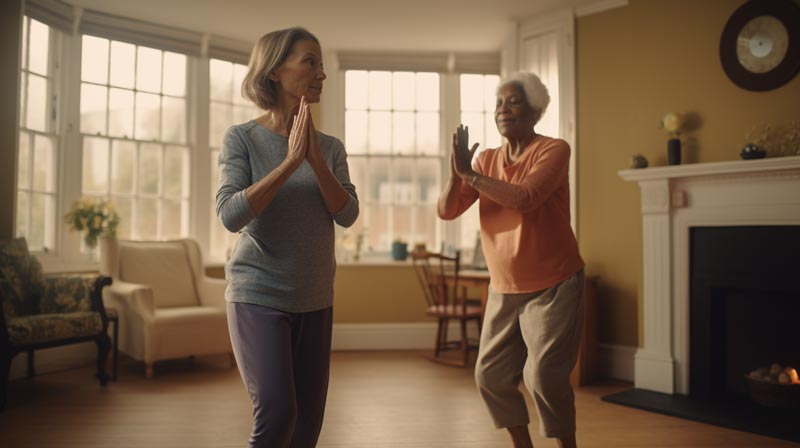By BeSund Editorial Team 11/07/2023 Modified Date: 03/05/2024
Alzheimer’s Disease
Discover how physical activity interacts with Alzheimer's disease
Alzheimer’s Disease and Physical Wellness

Understanding Alzheimer’s Disease and Physical Wellness
Understanding Alzheimer’s Disease and Physical Wellness starts with how Alzheimer’s Disease affects memory, cognition, and daily activities. It’s a form of dementia that not only deteriorates mental capabilities but also profoundly impacts physical wellness. This makes it highly relevant to our central focus at BeSund, which aims to be the go-to resource for evidence-based health and exercise information.
The global rise in Alzheimer’s cases reveals an urgent need to explore preventative and management strategies. As a disease that hampers both mental and physical faculties, Alzheimer’s demands a multidisciplinary approach to care. Exercise and physical well-being have been shown to mitigate some of the disease’s debilitating effects, highlighting the importance of a balanced lifestyle.
By exploring the connections between Alzheimer’s disease and physical wellness, we aim to provide insights into maintaining a better quality of life despite the illness. Given that Alzheimer’s can lead to reduced mobility and increased frailty, understanding how to maintain physical wellness is crucial.
Alzheimer’s Disease and Physical Wellness: A Global Data Overview
The incidence of Alzheimer’s disease is a subject that commands attention. According to the World Alzheimer Report 2022, approximately 75% of individuals with dementia remain undiagnosed globally, which can rise to as high as 90% in some regions. This condition accounts for 50%-75% of all dementia cases.
To add another layer to this data, consider the interactive stacked bar chart above, based on the WHO mortality database. This chart provides a nuanced look at total deaths year-on-year, beginning with 7.6 million in 1950 and rising to more than 27 million in 2020. The graph also enables a focused look at Alzheimer’s deaths, offering an opportunity for deeper understanding.
The chart also separates the data by gender, allowing for a more detailed view of how Alzheimer’s affects both men and women in the context of overall mortality. This visual approach aligns closely with the insights provided by the World Alzheimer Report.
Offering a comprehensive view of Alzheimer’s and related dementias becoming more prominent, indicating a growing concern for these diseases in the context of global mortality.
What the Latest Data Uncovers About Alzheimer’s Disease and Physical Wellness
The urgency around Alzheimer’s Disease and Physical Wellness is confirmed by recent data. The disease not only deteriorates mental health; it also severely affects physical wellness. This necessitates a multidimensional strategy for disease management and prevention.
Focused analysis shows that Alzheimer’s patients have a higher propensity for falls, compromising their physical wellness. Such insights underscore the complexity of caring for these individuals.
This comprehensive guide explores the vital relationship between Alzheimer’s Disease and Physical Wellness. The aim is to offer practical advice on physical performance, exercise management, and lifestyle choices for those with Alzheimer’s. This sets the foundation for our ensuing discussion on the impact of Alzheimer’s on physical performance.
The Impact of Alzheimer’s Disease on Physical Performance
Alzheimer’s disease not only affects cognitive function but also has a profound impact on physical performance. The condition leads to a decline in cognitive and motor skills, affecting the individual’s physical capabilities.
- Motor Function Decline: As Alzheimer’s progresses, there is a noticeable degradation in motor function. Simple tasks like walking, grasping objects, or maintaining balance become increasingly difficult. These changes are not merely a byproduct of ageing but are often accelerated due to Alzheimer’s disease itself. A consistent physical activity routine can help slow this decline and improve the quality of life for a more extended period.
- Musculoskeletal Issues: The lack of physical activity can lead to further complications such as muscle atrophy and joint stiffness. These issues exacerbate the existing motor function problems and can result in a cycle of physical decline.
- Impact on Daily Living: The loss of motor skills significantly impacts daily activities. Simple tasks like dressing, cooking, or moving from one place to another become increasingly challenging. This loss of autonomy increases the need for care assistance, limiting the individual’s independence.
- Physical activity as a Countermeasure: Regular physical exercise can play a crucial role in breaking this cycle of decline. Exercise promotes better sleep, improves mood, and enhances overall well-being. It can also slow the rate of cognitive and physical decline. The best type of physical activity depends on various factors, including age, stage of Alzheimer’s, and existing physical fitness.
- Safety Precautions: Before initiating an exercise regime, consultation with a healthcare provider is essential, especially for other health issues like high blood pressure or a history of falls.
The impact of Alzheimer’s disease on physical wellness performance is significant but not insurmountable. Consistent physical activity, tailored to the individual’s abilities and limitations, can mitigate some of these impacts and improve quality of life.

Exercise as a Management Tool for Alzheimer’s Disease
Exercise is an effective management tool for Alzheimer’s Disease and Physical Wellness. Integrating physical activity into the daily routine of Alzheimer’s patients has been shown to provide cognitive and physical benefits. In this manner, it is a complementary approach to traditional medical treatments.
- Importance of Exercise in Alzheimer’s Management
Regular physical activity can significantly improve the quality of life for individuals with Alzheimer’s. It aids in enhancing muscle strength, balance, and cardiorespiratory fitness. These improvements can help manage symptoms and even slow down the progression of the disease. - Exercise and Cognitive Function
There’s a growing body of evidence that exercise may improve cognitive function and possibly delay the onset of Alzheimer’s disease. Physical activity enhances neuroplasticity by promoting new neurons’ growth, helping maintain a healthier brain. - Exercise and Mood Regulation
Patients with Alzheimer’s often experience mood swings and depression. Exercise has been proven to improve mood and mental well-being. Which aids in the overall management of Alzheimer’s Disease and Physical Wellness. - Exercise Types and Their Benefits
Different forms of exercise offer various benefits. For instance, aerobic exercise improves cardiovascular health and may reduce the risk of developing Alzheimer’s disease. On the other hand, resistance training can help maintain muscle mass and strength, which is often compromised in Alzheimer’s patients. - Professional Guidance Required
Before incorporating an exercise programme, it’s crucial to consult healthcare providers to ensure that the chosen activities are appropriate and safe. Consideration must also be given to the stage of Alzheimer’s and other health conditions an individual may have.
By making exercise a regular part of the care plan for Alzheimer’s Disease and Physical Wellness, it is possible to improve quality of life significantly.

Recommended Exercises for Individuals with Alzheimer’s Disease and Physical Wellness
Physical activity is not just a cornerstone for general well-being; it’s also a potent tool for managing Alzheimer’s Disease and Physical Wellness. Research consistently shows that targeted exercises can significantly ameliorate the physical and cognitive decline associated with Alzheimer’s disease.
Here are some specific exercises recommended for individuals with Alzheimer’s, supported by scientific evidence.
1. Aerobic Exercises: Boosting Cardiovascular and Cognitive Health
Aerobic exercises like walking, swimming, and cycling have shown promising results in improving cardiovascular health and cognitive function. These activities elevate heart rate, increase lung capacity, and engage multiple muscle groups, contributing to overall physical wellness.
-
- Frequency: Aim for 150 minutes of moderate aerobic exercise per week.
- Safety Tips: Always start slow and gradually increase intensity. Consult healthcare providers for a tailored exercise programme.
2. Resistance Training: Strengthening Muscles and Joints
Resistance exercises like weight lifting or using resistance bands can help maintain muscle mass and joint flexibility. These exercises are particularly crucial for Alzheimer’s patients, who often experience muscle atrophy and joint stiffness.
-
- Frequency: Two to three sessions per week.
- Safety Tips: Professional guidance is advised to ensure the correct form and to prevent injuries.
3. Balance and Flexibility: Promoting Mobility and Reducing Falls
Exercises like tai chi or yoga improve balance and flexibility. Improved balance can significantly reduce the risk of falls, a common issue among individuals with Alzheimer’s.
-
- Frequency: Incorporate into your weekly routine.
- Safety Tips: Use supporting equipment like handrails or consult a physiotherapist for a tailored programme.
4. Mind-Body Exercise: Enhancing Mental Well-being
Mind-body exercises like meditation and deep breathing can help regulate mood and mental well-being. This is essential for managing mood swings and depressive symptoms often seen in Alzheimer’s patients.
-
- Frequency: Daily or as needed.
- Safety Tips: Always perform these exercises in a calm and quiet environment.
5. Consult a Healthcare Provider Before Starting an Exercise Regime
Due to the nature of the condition, it is of vital importance that you consult a healthcare adviser or provider. Before starting any new exercise programme, it is essential, especially when other health conditions like high blood pressure or diabetes are present.
Safety Measures and Precautions for Exercising with Alzheimer’s Disease
Regarding Alzheimer’s Disease and Physical Wellness, safety during exercise is paramount. While physical activity offers myriad benefits for managing Alzheimer’s symptoms, it also brings specific challenges that require attention.
Adopting a thorough safety protocol can mitigate risks and maximise the efficacy of your exercise regimen. Below is a list synthesised from general guidelines and best practices for exercising with Alzheimer’s Disease.
1. Medical Consultation: The First Step
Before diving into any exercise programme, consulting with a healthcare provider is crucial. Due to the multifaceted nature of Alzheimer’s, a comprehensive medical evaluation is essential. The idea is to have a tailored exercise programme that aligns with the individual’s current state of health.
2. Monitoring and Supervision: A Non-Negotiable
For Alzheimer’s patients, close monitoring during exercise is non-negotiable. Whether it’s a family member or a trained professional, ensure that someone is always present to provide immediate assistance. This is particularly important for those with a history of falls or other mobility issues.
3. Environmental Safety: Setting Up the Right Space
The environment in which exercise is conducted plays a critical role in ensuring safety. An ideal exercise space should be clutter-free with ample room for movement. Remove any tripping hazards and provide good lighting to minimise the risk of falls.
4. Equipment Safety: Choose Wisely
The choice of exercise equipment can significantly impact safety. Opt for non-slip mats, sturdy handrails, and well-maintained equipment. If resistance bands or weights are used, ensure they are appropriate for the individual’s strength and skill level.
5. The Importance of Hydration and Nutrition
Proper hydration and nutrition are vital when incorporating exercise into an Alzheimer’s care plan. Dehydration and low blood sugar can exacerbate cognitive and physical symptoms, so ensure that water and nutritious snacks are readily available.
6. Emergency Protocols: Be Prepared
It’s prudent to have an emergency response plan in place. Keep a first-aid kit handy and ensure emergency contact numbers are easily accessible. An emergency protocol helps take swift action in case of untoward incidents.
7. Regular Reviews: Adapt and Evolve
The progression of Alzheimer’s Disease and Physical Wellness is unpredictable. Regular exercise programme reviews are needed to adapt to changes in the individual’s condition. Consult healthcare providers for these periodic assessments to make necessary adjustments.
Taking these safety measures and precautions seriously can help make exercise a safe and effective component of Alzheimer’s management. Careful planning, constant supervision, and adaptability are crucial to integrating exercise into the life of someone living with Alzheimer’s Disease and Physical Wellness.

Living with Alzheimer’s Disease and Physical Wellness: Lifestyle Tips
Living with Alzheimer’s Disease and Physical Wellness necessitates a holistic approach that marries medical treatment with lifestyle adjustments. It’s not merely about managing symptoms but enhancing quality of life in the most comprehensive manner possible.
Below are lifestyle tips backed by scientific data to complement traditional Alzheimer’s management strategies.
- Nutritional Interventions: Diet is pivotal in managing Alzheimer’s symptoms and supporting physical wellness. Omega-3 fatty acids, antioxidants, and a low-sugar diet are not just buzzwords but scientifically supported cornerstones in Alzheimer’s care.
- Social Engagement: Isolation exacerbates Alzheimer’s symptoms and can lead to physical stagnation. Regular social interaction, even if virtual, helps maintain cognitive function and emotional well-being, which are crucial for physical wellness.
- Sleep Hygiene: Poor sleep not only aggravates Alzheimer’s symptoms but also impairs physical wellness. Adopting good sleep hygiene, such as a consistent sleep schedule and a conducive sleep environment, can make a significant difference.
- Stress Management: Elevated stress levels have a direct, detrimental impact on Alzheimer’s progression and physical health. Mindfulness and relaxation techniques offer a non-pharmacological route to stress management, which is crucial for those with Alzheimer’s.
- Scheduled Physical Activity: Regularity trumps intensity when exercising for Alzheimer’s patients. Even light activities like walking or gardening can have a cumulative positive effect on cognitive and physical wellness.
- Medical Reviews: Periodic assessments with healthcare providers should be non-negotiable. These reviews offer the chance to fine-tune treatment plans and make necessary lifestyle adjustments.
By considering these lifestyle tips, one can navigate the complexities of living with Alzheimer’s Disease and Physical Wellness more effectively.
Each tip is rooted in scientific evidence and aims to provide a multidimensional approach to Alzheimer’s care, making it more than just a management strategy but a way of life.
Sources
• Ahlskog JE, Geda YE, Graff-Radford NR, Petersen RC. Physical exercise as a preventive or disease-modifying treatment of dementia and brain ageing. Mayo Clin Proc. 2011 Sep;86(9):876-84.
• Akter K, Lanza EA, Martin SA, Myronyuk N, Rua M, Raffa RB. Diabetes mellitus and Alzheimer’s disease: shared pathology and treatment? Br J Clin Pharmacol. 2011 Mar;71(3):365-76.
• Alzheimer’s Disease International. (21st September 2022). ‘World Alzheimer Report 2022, Life after diagnosis: Navigating treatment, care and support’.
• Alzheimer’s Disease International. ‘Alzheimer’s disease’.
• Barnes JN. Exercise, cognitive function, and ageing. Adv Physiol Educ. 2015 Jun;39(2):55-62.
• Bos D, Vernooij MW, Elias-Smale SE, Verhaaren BF, Vrooman HA, Hofman A, Niessen WJ, Witteman JC, van der Lugt A, Ikram MA. Atherosclerotic calcification relates to cognitive function and to brain changes on magnetic resonance imaging. Alzheimers Dement. 2012 Oct;8(5 Suppl):S104-11.
• Buchman AS, Boyle PA, Yu L, Shah RC, Wilson RS, Bennett DA. Total daily physical activity and the risk of AD and cognitive decline in older adults. Neurology. 2012 Apr 24;78(17):1323-9. doi: 10.1212/WNL.0b013e3182535d35. Epub 2012 Apr 18.
• Carvalho A, Rea IM, Parimon T, Cusack BJ. Physical activity and cognitive function in individuals over 60 years of age: a systematic review. Clin Interv Aging. 2014 Apr 12;9:661-82.
• Cebr. (September 2019). The economic cost of dementia to English businesses – 2019 update A report for Alzheimer’s Society. Centre for Economics and Business Research.
• Covell GE, Hoffman-Snyder CR, Wellik KE, Woodruff BK, Geda YE, Caselli RJ, Demaerschalk BM, Wingerchuk DM. Physical activity level and future risk of mild cognitive impairment or dementia: a critically appraised topic. Neurologist. 2015 Feb;19(3):89-91.
• Erten-Lyons D, Woltjer RL, Dodge H, Nixon R, Vorobik R, Calvert JF, Leahy M, Montine T, Kaye J. Factors associated with resistance to dementia despite high Alzheimer disease pathology. Neurology. 2009 Jan 27;72(4):354-60.
• Hamer M, Chida Y. Physical activity and risk of neurodegenerative disease: a systematic review of prospective evidence. Psychol Med. 2009 Jan;39(1):3-11.
• Kramer AF, Erickson KI. Capitalising on cortical plasticity: influence of physical activity on cognition and brain function. Trends Cogn Sci. 2007 Aug;11(8):342-8.
• Mazereeuw G, Lanctôt KL, Chau SA, Swardfager W, Herrmann N. Effects of omega-3 fatty acids on cognitive performance: a meta-analysis. Neurobiol Aging. 2012 Jul;33(7):1482.e17-29.
• Morris MC. The role of nutrition in Alzheimer’s disease: epidemiological evidence. Eur J Neurol. 2009 Sep;16 Suppl 1(Suppl 1):1-7.
• Paillard T, Rolland Y, de Souto Barreto P. Protective Effects of Physical Exercise in Alzheimer’s Disease and Parkinson’s Disease: A Narrative Review. J Clin Neurol. 2015 Jul;11(3):212-9.
• Stern Y. Cognitive reserve in ageing and Alzheimer’s disease. Lancet Neurol. 2012 Nov;11(11):1006-12.
• World Health Organization (WHO). ‘WHO mortality database’.
• Zieschang T, Schwenk M, Becker C, Uhlmann L, Oster P, Hauer K. Falls and Physical Activity in Persons With Mild to Moderate Dementia Participating in an Intensive Motor Training: Randomized Controlled Trial. Alzheimer Dis Assoc Disord. 2017 Oct-Dec;31(4):307-314.


